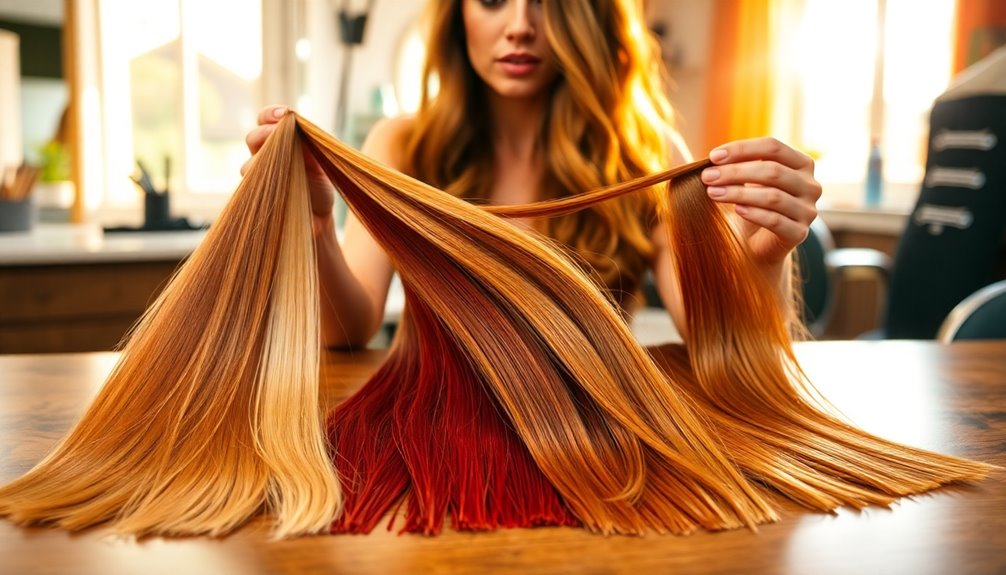To choose the right hair color for your skin tone, first, determine your undertone by checking your wrist veins—blue for cool, green for warm. Then, opt for shades that complement your undertone: cool tones suit icy blondes and deep blacks, while warm tones thrive in golden and honey shades. Don't forget to take into account maintenance and care needed for your color choice. If you want to explore more tips on selecting the perfect shade, keep going!
Key Takeaways
- Determine your undertone by checking wrist veins: blue/purple for cool, green for warm, and a mix for neutral.
- Use the white paper test to identify undertones: yellowish skin indicates warm, while bluish skin suggests cool.
- Choose hair colors that complement your undertone: cool tones suit icy blondes, while warm tones favor golden and copper shades.
- Maintain hair color with color-safe shampoos and regular moisturizing treatments to preserve vibrancy and hair health.
- Avoid following trends blindly; select hair colors that enhance your unique skin tone and undertones for the best results.
Understanding Skin Undertones

How can you choose the perfect hair color if you don't understand your skin undertones? Knowing whether you have cool tones, warm tones, or neutral undertones is key.
To determine your undertone, check your veins: blueish or purple veins usually signal cool undertones, while green veins indicate warm tones. If you're unsure, hold a piece of white paper against your skin—if it appears yellowish, you likely have warm undertones. Additionally, best hair colors can enhance your overall look by harmonizing with your unique undertones.
Check your veins to identify your undertones: blue/purple for cool, green for warm. A white paper test can also help!
Those who tan easily usually fall into the warm category, while those who burn often have cool undertones. By identifying these undertones, you can select hair colors that enhance your natural complexion, making you look radiant and vibrant. Additionally, understanding hair types can further refine your color choices and styling techniques.
Understanding your undertones is essential for making the right choice!
How to Determine Your Undertone

Determining your skin undertone can feel tricky, but it's essential for finding the right hair color. Start by checking your wrist veins: blue or purple indicates cool undertones, green suggests warm undertones, and a mix points to neutral undertones. You can also conduct the white paper test; if your skin looks yellowish against white paper, you likely have warm undertones. Try the blusher test too—if pink blush suits you, you're cool; if peach works better, you're warm. Finally, the jewelry test helps: silver favors cool undertones, gold signals warm, and if both look good, you have neutral undertones. Additionally, understanding your undertone can assist in choosing products that enhance your skin health and overall appearance. It's also worth noting that using certain essential oils, like lavender oil, can promote a calming effect that may help reduce stress during the hair-coloring process.
| Test | Result |
|---|---|
| Wrist Veins | Blue/Purple: Cool |
| Green: Warm | |
| White Paper Test | Yellowish: Warm |
| Bluish: Cool | |
| Blusher Test | Pink: Cool |
| Peach: Warm | |
| Jewelry Test | Silver: Cool |
| Gold: Warm |
Best Hair Colors for Cool Undertones

Finding the right hair color becomes much easier once you know you have cool undertones. You'll want to choose shades that enhance your natural hues. Icy platinum blonde and deep black create a sophisticated look without clashing. If you have fair skin, light ashy colors and fun pastel shades are particularly flattering.
For medium skin tones, cool reds and plum shades work beautifully. Dark skin with cool undertones looks stunning in bold colors like jewel-toned purples and icy blondes, which enhance your complexion's richness. Additionally, Halloween traditions often incorporate vibrant colors that can inspire your hair choices. Avoid warm hair colors with golden or orange hues, as they can create an unflattering contrast. Furthermore, incorporating nutritional benefits from a balanced diet can further enhance your overall appearance. Embrace these hair colors, and you'll be sure to elevate your style!
Best Hair Colors for Warm Undertones

When you've got warm undertones, choosing the right hair color can truly enhance your natural glow.
Opt for shades that feature golden, copper, and honey tones to complement your skin. Here are some ideal shades to contemplate:
- Chocolate brown for medium skin adds depth.
- Strawberry blonde and golden blonde bring out radiance in fair skin.
- Rich warm colors like golden brown and butterscotch work beautifully with dark skin.
Avoid overly cool tones, as they can wash out your vibrant warm undertones, leading to a less flattering appearance. Instead, embrace these colors to highlight your unique warmth and create a stunning look that enhances your natural beauty. Incorporating omega-3 fatty acids from sources like chia seeds can also support hair health for a more vibrant look. Additionally, chia seeds are high in fiber, which can promote overall well-being and may even help maintain a healthy weight.
Best Hair Colors for Neutral Undertones

For those with neutral undertones, the world of hair color opens up a palette of possibilities that can enhance your natural beauty.
Explore the vibrant world of hair color options that beautifully complement your neutral undertones.
You've got versatile choices that range from warm shades to vibrant colors. If you have fair skin, consider rich chocolate or strawberry blonde, which will complement your complexion beautifully. Incorporating essential oils for aromatherapy can also elevate your overall grooming experience.
For medium skin, classic combinations like amber chocolate and dark brown add warmth without clashing.
If you have dark skin, vibrant colors such as burgundy or bubblegum pink create a striking contrast, while natural shades one to two tones lighter or darker give you a seamless look.
Don't forget to incorporate highlights and lowlights to add dimension and depth, elevating your overall hair color and texture. Additionally, keep in mind that the rise of sustainable grooming practices reflects a growing consumer preference for eco-friendly options, which can influence your choice of hair color products.
Tips for Choosing the Right Shade

How can you assure the hair color you choose enhances your unique features? Start by identifying your skin tone and undertone. You can check your veins—blue means cool, green indicates warm, and a mix suggests neutral undertones.
The white paper test is another quick method: yellowish skin against white hints at warm undertones, while a pinkish hue suggests cool.
When choosing hair color, consider these tips:
- Cool shades: Opt for ash blonde, platinum, or true red.
- Warm shades: Choose golden, copper, or honey tones.
- Neutral undertones: Look for rich chocolate or strawberry blonde.
Consulting a professional colorist assures you find the best shades to enhance your beauty and achieve a harmonious look!
Hair Color Maintenance and Care

To keep your hair color looking fresh, using color-safe shampoos and conditioners is a must.
Regular conditioning treatments will also help keep your strands hydrated and vibrant.
Regular Conditioning Treatments
Regular conditioning treatments are essential for maintaining the health and vibrancy of your color-treated hair. They help lock in moisture and shine, preventing dryness and brittleness.
To keep your hair looking its best, consider these tips:
- Use color-safe conditioners to preserve your hair color and prevent stripping.
- Incorporate a weekly hydrating mask for extra nourishment and resilience against damage.
- Add essential oils, like argan or coconut oil, to enhance smoothness and reduce frizz.
These practices not only enhance the appearance of your hair color but also support healthy hair growth by keeping your scalp and strands well-hydrated.
With the right conditioning treatments, your hair will remain vibrant and beautiful, complementing your skin tone perfectly.
Color-Safe Shampoo Use
Using a color-safe shampoo is essential for preserving the vibrancy of your hair dye, especially if you've recently colored your locks. These shampoos are sulfate-free, preventing fading and dryness in color-treated hair.
By incorporating moisturizing ingredients like argan oil or shea butter, they help maintain hair hydration and softness. Additionally, many color-safe shampoos contain antioxidants and UV filters that protect your hair color from environmental damage caused by sunlight and pollution.
Using a color-safe shampoo regularly can extend the life of your hair color by up to 50%. Remember to wait at least 48 hours after coloring before using it, allowing your color to set properly and minimizing washout.
Common Mistakes to Avoid

When choosing a hair color, you can't ignore the importance of your undertone, as it plays an essential role in how the shade will look on you.
Relying solely on trends without considering maintenance can lead to frustration down the line. Make sure to think about how much upkeep you're willing to commit to before making a final decision.
Ignoring Undertone Importance
Many people overlook the significance of their skin's undertone, which can lead to hair color choices that clash with their natural complexion. Ignoring your undertone can result in an unflattering appearance.
Here's why identifying your undertone is essential:
- Cool undertones: Favor hair colors with ash or pearl bases.
- Warm undertones: Thrive with golden or copper shades.
- Neutral undertones: Need a balance of warm and cool to avoid a washed-out look.
Using the wrong hair color can amplify unwanted hues in your skin. For instance, reddish tones may become more pronounced in cool undertones.
To enhance your beauty, take the time to choose hair colors that flatter your overall look by understanding your skin undertones.
Overlooking Maintenance Requirements
Overlooking maintenance requirements can lead to frustration and added costs in your hair coloring journey. When choosing hair colors, it's essential to take into account how much upkeep you're willing to commit to.
Vibrant reds or platinum blondes demand frequent touch-ups, which can strain busy lifestyles. If you opt for warm colors, be prepared for potential brassiness or fading that requires regular toning. For those with cool undertones, icy blondes may need special treatments to prevent yellowing.
Assess your hair's health condition before committing to high-maintenance colors, as damaged hair won't hold color well.
Finally, factor in the cost of professional services or products to maintain your desired hue, as this can greatly impact your overall look.
Relying Solely on Trends
Choosing a hair color based solely on trends can lead to disappointing results. Trends often overlook your unique skin undertones, which are essential for enhancing your natural beauty. Instead of chasing seasonal fads, focus on shades that truly complement you.
Consider these points:
- Icy blondes can wash out warm tones.
- Vibrant reds might clash with cool undertones.
- Celebrity influences rarely account for your specific features.
Always prioritize personalized recommendations from a stylist who understands the importance of matching hair color to your skin tone.
They can help you find shades that not only align with trends but also suit your individual warmth or coolness, ensuring you look your best regardless of fleeting styles.
Frequently Asked Questions
How Do I Know What Hair Color Suits My Skin Tone?
To know what hair color suits your skin tone, start by examining your skin's undertones.
Check your wrist veins; blue or purple hints at cool tones, while green suggests warm. You can also hold a white sheet against your skin—if it appears pink or blue, you're likely cool-toned.
Consider your blush preference too; if pink suits you better, you're cool.
Finally, think about whether gold or silver jewelry flatters you more.
Should You Go Darker or Lighter With Hair Color as You Age?
As you age, going lighter with your hair color often works in your favor.
Lighter shades can soften your features and help mask fine lines, creating a more youthful appearance. Dark colors might emphasize wrinkles and dullness.
Instead of making drastic changes, consider gentle shifts to lighter tones or adding highlights for dimension.
Consulting a professional colorist can guide you in finding the best approach that complements your evolving look beautifully.
How Do I Know My Hair Color Shade?
Did you know that around 75% of people don't know their true hair color shade?
To find yours, start by identifying your skin undertone—check your veins or see how different jewelry looks on you.
Cool undertones usually suit ashy shades, while warm ones shine with golden hues.
If you're neutral, you've got flexibility!
For the best results, consider consulting a professional colorist who can tailor recommendations just for you.
How Do You Know What Color Suits Your Skin Tone?
To know what color suits your skin tone, start by checking your undertone.
Look at your veins; if they're blue or purple, you've got cool undertones, while green indicates warmth.
Try the white paper test—if your skin looks yellowish next to the paper, you're warm-toned.
Experiment with different jewelry, too; gold flatters warm tones, while silver suits cool.
Combine these methods for a clearer picture of what colors will enhance your natural beauty.
Conclusion
Choosing the right hair color for your skin tone can transform your look and boost your confidence. Whether you have cool, warm, or neutral undertones, there's a perfect shade waiting for you. Just like the ancient alchemists sought to turn lead into gold, finding your ideal color can feel like striking that magical balance. Remember to maintain your color with care, and avoid common pitfalls. Embrace your unique beauty, and let your hair shine like a star in the night sky!










